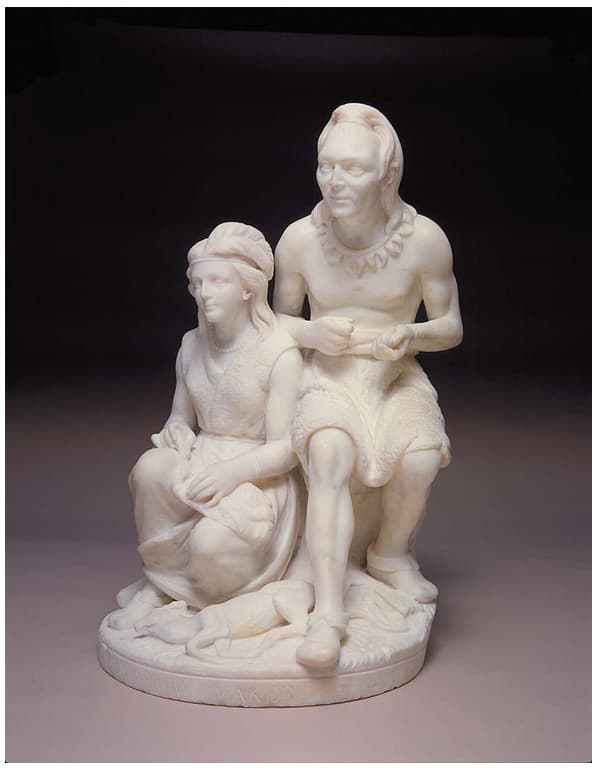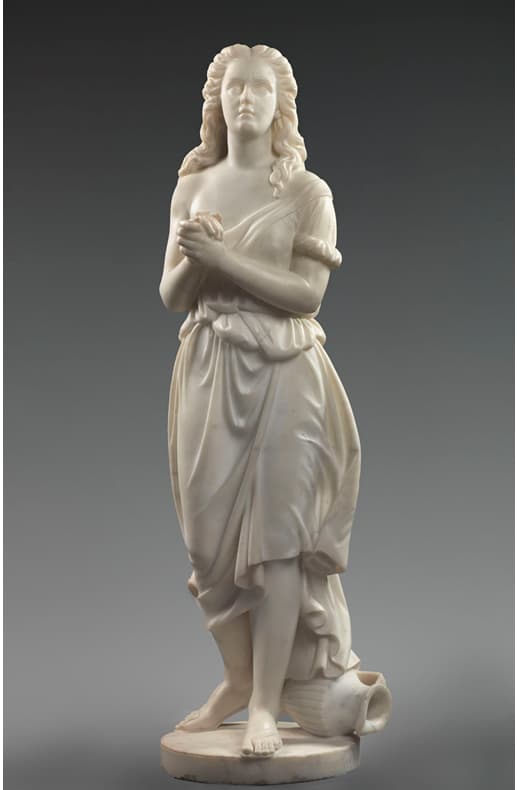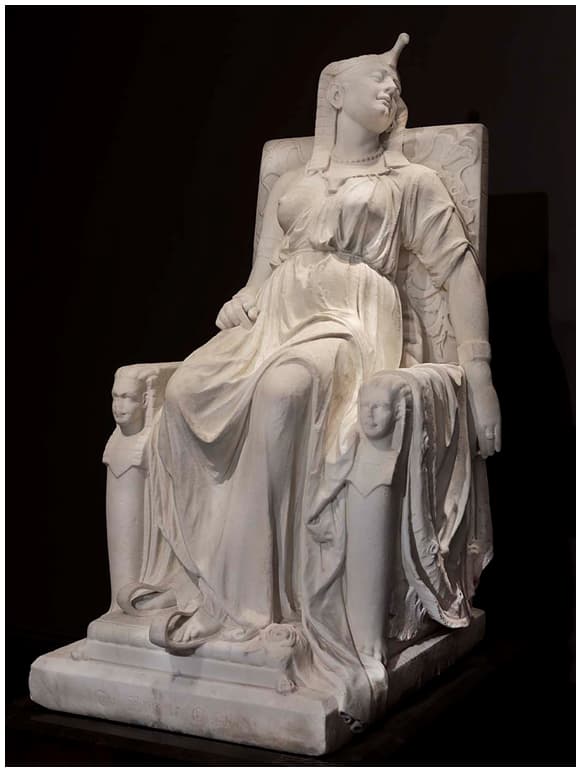Specific sculptures
There are forty-six sculptures by Edmonia that have been referenced in written work but many are unknown. 30 In my unit, I will focus on three. The Smithsonian American Art Museum has eight of her sculptures, which is the largest collection. I will be using three of these. Howard University has one, which I will also be using.
Forever Free
Done just four years after the Emancipation Proclamation, this marble sculptures depicts an African American slave at the moment of emancipation. His arm is raised with the broken chain still attached. Kneeling next to him is a woman, his wife or mate, with more racially neutral features and long straight hair. The male has clearly ethnic features and hair and is standing heroically almost defiantly. The female is fully clothed which in and of itself is unusual. Often female slaves in Neoclassical sculpture were depicted nude or semi-nude to suggest their sexual availability or as a reference to classical nudes. It is in the Howard University Art Gallery, Washington, D.C.
Old Indian Arrowmaker
There are at least three versions of this subject, which was quite popular. Two are owned by the Smithsonian. Made in 1872, the sculpture shows the Indian and his daughter: he is making arrows while she is making moccasins. The daughter, apparently modeled after Edmonia's earlier versions of Minnehaha, doesn't look as naturalistic as the father. The father is clearly Native American, based on his features while his daughter is more idealized. 31 It is a small sculpture, just under two feet, and is filled with intricate details. The authentic Chippewa clothing, moccasins and jewelry are very well done and the sculpture has strong texture, something not typically found in Neoclassical work.

Hagar
Carved in 1875, in marble, this sculpture depicts the biblical Hagar, the slave of Abraham who had a son, Ishmael, with Abraham, and then was later sent away to the wilderness. While the sculpture was meant to depict an African slave, the features and hair are modeled in a more idealized manner with no characteristics that would be associated with Africans. Hagar has Caucasian features and straight long hair. Edmonia commenting on another version of Hagar, now lost, that she had done, says "I have strong sympathy for all women who have struggled and suffered." 32 The sculpture is in the Smithsonian American Art Museum but not currently on display.

The Death of Cleopatra
"The Death of Cleopatra" is considered by many to be Edmonia Lewis' masterpiece. Carved of Italian marble, it is five feet tall and weighs two tons. The subject is Cleopatra VII, who was the queen of Egypt from 51-30 B.C. In the sculpture she is depicted at the moment of her death, sitting on her throne, her head back and the deadly asp still in her hand. This very realistic portrait depicts Cleopatra just after the bite of the asp which, depending on how you read her expression, may have challenged the Victorian notions of sentimentality about death. Regardless, the sculpture created a stir in the 1876 Centennial Exposition in Philadelphia. The Philadelphia Exposition was a juried exhibition and Lewis was the only black artist but not the only female one. The sculpture was shown in Memorial Hall close to another version of Cleopatra, by William Wetmore Story, a contemporary Neoclassical sculptor who was convinced that women could not produce worthy marble sculptures. Edmonia's work was later displayed at the Chicago Industrial Exposition in 1878. Lewis decided after that exhibit to store it in Chicago instead of shipping it back to Rome 33. The sculpture was next seen in a saloon in 1892 and then was sold to the owner of a racetrack where it was used as a grave marker for a racehorse named Cleopatra. The statue stayed in place, even though the land's use changed from racetrack to golf course to factory, until 1972, when the postal service built on the land and the sculpture was moved to a salvage yard. 34
In the mid-1970s, a Boy Scout troop "rescued" the statue and cleaned it and painted it. In 1987, the sculpture was given to the Forest Park Historical Society and was identified two years later as "The Death of Cleopatra" by Edmonia Lewis It was then given to the Smithsonian National Museum of American Art in 1994 where it was restored. 35 The sculpture is done in the neoclassical style and is slightly larger than life sized. Most of her works before Cleopatra were smaller pieces. As she had gained knowledge and experience, her works had become larger but none like the scale of Cleopatra.


Comments: